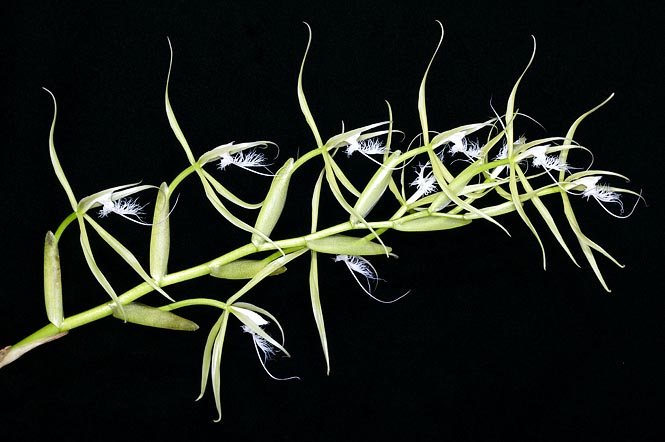Family : Orchidaceae

Text © Pietro Puccio

English translation by Mario Beltramini

Epidendrum ciliare has 10-30 cm inflorescences. Greenish 9 cm sepals and petals, white labella © Giuseppe Mazza
The name of the genus comes from the combination of the Greek terms “epi” = over and “déndron” = tree, with reference to the various species of the genus which live on the trees; the name of the species is the Latin term “ciliaris”, from “cilium” = eyelash, then equipped with eyelashes, with reference to the long fringes at the sides of the labellum. Common names: eyelash orchid, fringed star orchid, hairy-lip epidendrum (English).
The Epidendrum ciliare L. (1759) is an epiphytic or lithophytic species with creeping rhizome from which originate some cylindrical or fusifom pseudobulbs, slightly compressed, 10-20 cm long, with, at the apex, 1-2 leaves (rarely 3), coriaceous, oblong, 10-30 cm long and 2-6 cm broad, of glossy green colour.
It has terminal racemose inflorescences, usually in winter, 10-30 cm long, covered at the base by imbricate sheaths speckled with purple, carrying 5-10 or more waxy flowers, perfumed, of about 13 cm of diameter, with sepals and petals of greenish yellow colour on which stands out the white labellum.
The sepals are linear-lanceolate, up to 9 cm long and 0,5 cm broad, of the same size of the sepals or little less, are falcate, the labellum has three deeply incised lobes, the lateral ones, 3,5 cm long and 0,5 cm broad, have the outer edges fringed at length, the central one, filiform, is up to 6 cm long. It reproduces by seed, in vitro, and by division with each section provided at least with 3-4 pseudobulbs.
It is one of the most appreciated species due to the facility of cultivation and the particularity of its delicate and pleasantly perfumed flowers, especially during the night, and long-lasting, three weeks about. In spring-summer, during the vegetative period, it requires a slightly shaded position, medium-high temperatures, abundant and regular waterings, but allowing the compost to slightly dry up before giving water again, and high atmospheric humidity, by the 60-80%.
From late autumn, the waterings are to be reduced, but without ever leaving the substratum to dry up completely, allowing a slight resting period with temperatures not under the 15 °C; luminosity must be high, also direct sun, but always with a good movement of air.
For the waterings and nebulisations is to be used rain water, or water obtained by reverse osmosis or demineralised; the fertilizations, duly distributed and alternated, in way to avoid salts accumulations at the roots, are to be done during the vegetative period, preferably with hydro-soluble balanced products, with microelements, at ¼ of the dosage suggested on the package.
It can be mounted on bark, raft of cork or of roots of arborescent ferns, or cultivated in pots or baskets with much draining and aerated compost, which may be formed by medium cut fragments of bark and sphagnum or coir. Movements and divisions are to be done at the moment when the new roots do appear.
The species is inscribed in the appendix II of the CITES (species whose trade is internationally ruled).
Synonyms: Auliza ciliaris (L.) Salisb. (1812); Epidendrum cuspidatum Lodd. (1817); Coilostylis emarginata Raf. (1838); Epidendrum viscidum Lindl. (1840); Epidendrum luteum Planch. (1858); Auliza ciliaris (L.) Lindl. ex Stein (1892); Phaedrosanthus ciliaris (L.) Kuntze (1902); Encyclia ciliaris (L.) A.Lemée (1955); Coilostylis ciliaris (L.) Withner & P.A.Harding (2004); Coilostylis cuspidata (Lodd.) Withner & P.A.Harding (2004).
→ For general notions about ORCHIDACEAE please click here.
